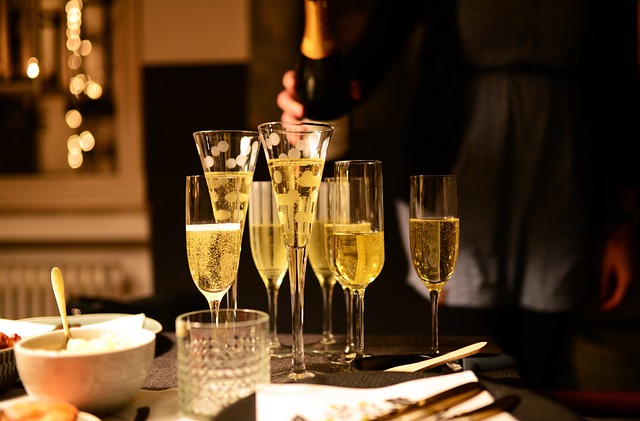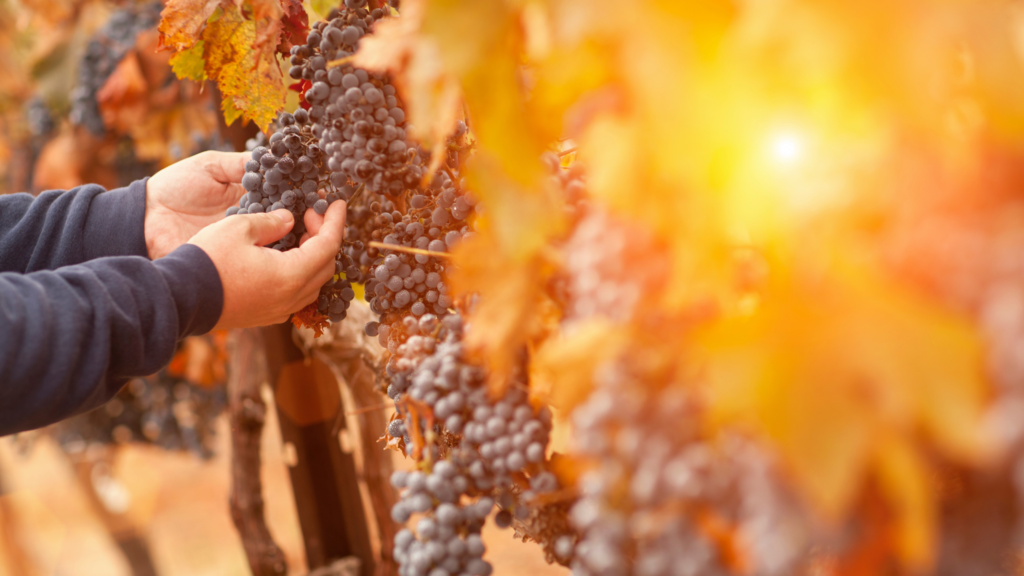-
Table of Contents
- The History of Champagne: A Journey Through Time
- Sustainable Wine Production in Champagne: A Closer Look
- Exploring the Vineyards of Champagne: A Guide for Wine Enthusiasts
- Champagne Tasting 101: How to Appreciate the Bubbles
- Eco-Friendly Transportation: Discovering Champagne by Train
- Sustainable Wine Tourism: Supporting Local Communities in Champagne
- Champagne and Gastronomy: Pairing Local Delicacies with Sparkling Wine
- Champagne’s Hidden Gems: Off-the-Beaten-Path Wineries to Visit
- Sustainable Wine Tourism: Preserving the Environment in Champagne
- Q&A
“Discover the essence of Champagne sustainably, one train ride at a time.”
Sustainable wine tourism is a growing trend that combines the enjoyment of wine with environmentally friendly practices. One fascinating destination for sustainable wine tourism is the Champagne region in France. This region is renowned for its exquisite sparkling wines and picturesque vineyards. Exploring Champagne by train offers a sustainable and scenic way to experience the beauty of the region while minimizing carbon emissions. In this introduction, we will delve into the concept of sustainable wine tourism and highlight the unique experience of exploring Champagne by train.
The History of Champagne: A Journey Through Time
The history of Champagne is a fascinating journey through time, filled with tales of innovation, passion, and perseverance. This renowned region in northeastern France has been producing sparkling wine for centuries, and its unique terroir and winemaking techniques have made it a symbol of luxury and celebration worldwide.
The story of Champagne begins in the 17th century when the Benedictine monk Dom Pérignon made significant contributions to the production of sparkling wine. He perfected the art of blending different grape varieties and introduced the use of cork stoppers to prevent the wine from losing its effervescence. His pioneering work laid the foundation for the Champagne we know today.
In the 19th century, Champagne experienced a period of rapid growth and international recognition. The invention of the riddling rack by Madame Clicquot revolutionized the process of removing sediment from the bottles, making it easier to produce clear and sparkling wines. This innovation, combined with the region’s unique chalky soil and cool climate, contributed to the exceptional quality of Champagne.
During this time, Champagne also became a favorite among European royalty and aristocracy. The region’s sparkling wines were served at royal courts and became synonymous with luxury and elegance. The demand for Champagne grew exponentially, leading to the establishment of prestigious Champagne houses such as Moët & Chandon, Veuve Clicquot, and Krug.
The 20th century brought both challenges and triumphs for Champagne. The devastation caused by World War I and the Great Depression had a significant impact on the region’s economy and production. However, Champagne producers demonstrated resilience and adaptability, finding new markets and expanding their reach.
In recent decades, sustainability has become a key focus for Champagne producers. The region’s unique ecosystem, with its rich biodiversity and fragile soil, requires careful stewardship to ensure its long-term viability. Many Champagne houses have implemented sustainable practices, such as organic and biodynamic viticulture, to minimize their environmental impact and preserve the region’s natural resources.
Today, Champagne is not only known for its exceptional wines but also for its commitment to sustainable wine tourism. One of the best ways to explore the region is by train, which offers a convenient and eco-friendly mode of transportation. The train journey from Paris to Reims, the capital of Champagne, takes just 45 minutes, allowing visitors to immerse themselves in the beauty of the vineyards and historic sites without the need for a car.
Once in Reims, wine enthusiasts can embark on a tour of the prestigious Champagne houses, such as Taittinger, Pommery, and Ruinart. These tours offer a unique opportunity to learn about the Champagne-making process, from grape harvesting to bottling, and to sample a variety of exquisite wines.
In addition to the Champagne houses, the region is dotted with charming villages and picturesque vineyards that are worth exploring. The village of Hautvillers, where Dom Pérignon lived and worked, is a must-visit for history buffs and wine lovers alike. Its narrow streets and quaint houses provide a glimpse into the past, while its vineyards offer breathtaking views of the surrounding countryside.
As sustainable wine tourism continues to gain popularity, Champagne remains at the forefront of this movement. By embracing environmentally friendly practices and offering unique experiences to visitors, the region ensures that future generations can continue to enjoy its rich history and exquisite wines. So, hop on a train and embark on a journey through time in Champagne, where tradition and innovation blend seamlessly to create a truly unforgettable experience.
Sustainable Wine Production in Champagne: A Closer Look
Sustainable Wine Tourism: Exploring Champagne by Train
Sustainable wine production has become a growing concern in recent years, as consumers become more conscious of the environmental impact of their choices. One region that has embraced sustainable practices is Champagne, known for its exquisite sparkling wines. In this article, we will take a closer look at sustainable wine production in Champagne and how it contributes to the overall experience of exploring this renowned wine region.
Champagne, located in northeastern France, is famous for its unique terroir, which gives its wines their distinctive character. The region’s chalky soil, combined with its cool climate, creates the perfect conditions for growing the grapes used in Champagne production. However, this delicate ecosystem requires careful management to ensure its long-term sustainability.
One of the key aspects of sustainable wine production in Champagne is the use of organic and biodynamic farming practices. Many vineyards in the region have transitioned to organic farming, which eliminates the use of synthetic pesticides and fertilizers. Instead, natural methods are employed to control pests and enrich the soil. Biodynamic farming takes this a step further, incorporating holistic principles that view the vineyard as a self-sustaining ecosystem. This approach includes practices such as planting cover crops, using compost, and following lunar cycles for planting and harvesting.
In addition to organic and biodynamic farming, Champagne producers are also implementing innovative techniques to reduce their carbon footprint. For example, many vineyards have adopted precision viticulture, which uses technology to optimize vineyard management. This includes using drones to monitor vine health, soil moisture sensors to optimize irrigation, and GPS-guided machinery to minimize fuel consumption. These advancements not only improve efficiency but also reduce the environmental impact of wine production.
Another important aspect of sustainable wine production in Champagne is the preservation of biodiversity. Vineyards in the region are home to a wide variety of plant and animal species, many of which are unique to the area. To protect this biodiversity, producers are implementing measures such as creating wildlife corridors, planting hedgerows, and preserving natural habitats. These efforts not only contribute to the overall health of the ecosystem but also enhance the beauty of the vineyards, creating a more enjoyable experience for visitors.
When it comes to exploring Champagne, sustainable wine tourism offers a unique and enriching experience. One of the best ways to discover the region is by train, which not only reduces carbon emissions but also allows visitors to fully immerse themselves in the stunning landscapes. The train journey takes you through picturesque vineyards, charming villages, and historic towns, providing a glimpse into the rich history and culture of Champagne.
Once you arrive in Champagne, there are numerous sustainable wine tourism options to choose from. Many vineyards offer guided tours that showcase their sustainable practices, allowing visitors to learn about the winemaking process and taste their exquisite wines. Additionally, there are eco-friendly accommodations available, such as boutique hotels and bed and breakfasts, that prioritize sustainability in their operations.
In conclusion, sustainable wine production in Champagne is not only essential for preserving the region’s unique terroir but also contributes to the overall experience of exploring this renowned wine region. From organic and biodynamic farming practices to innovative techniques that reduce carbon emissions, Champagne producers are leading the way in sustainable viticulture. By embracing sustainable wine tourism and exploring Champagne by train, visitors can fully appreciate the beauty and taste of this exceptional wine region while minimizing their environmental impact.
Exploring the Vineyards of Champagne: A Guide for Wine Enthusiasts
Sustainable Wine Tourism: Exploring Champagne by Train
Exploring the Vineyards of Champagne: A Guide for Wine Enthusiasts
Champagne, the renowned region in northeastern France, is not only famous for its sparkling wine but also for its picturesque vineyards and charming villages. For wine enthusiasts looking to immerse themselves in the world of Champagne, there is no better way to explore the region than by train. Not only does this mode of transportation offer convenience and comfort, but it also aligns with the principles of sustainable tourism.
One of the main advantages of traveling to Champagne by train is the ease of access. The region is well-connected to major cities like Paris, making it a convenient destination for both domestic and international travelers. High-speed trains whisk visitors from the bustling capital to the heart of Champagne in just over an hour, allowing for a seamless journey that minimizes the carbon footprint.
Once in Champagne, wine enthusiasts can embark on a journey through the vineyards, discovering the secrets behind the production of the world’s most celebrated sparkling wine. The train stations in Reims and Epernay, the two main cities in the region, serve as perfect starting points for exploring the surrounding vineyards. From here, visitors can hop on local trains or hire bicycles to venture into the picturesque countryside.
Reims, often referred to as the capital of Champagne, is home to some of the most prestigious Champagne houses. A visit to the city would not be complete without a tour of the famous cellars of Veuve Clicquot, Taittinger, or Pommery. These tours offer a unique opportunity to learn about the intricate process of Champagne production, from grape harvesting to bottling, all while savoring the exquisite flavors of the region.
Epernay, on the other hand, is known for its Avenue de Champagne, a grand boulevard lined with elegant mansions that house some of the most renowned Champagne producers. A leisurely stroll along this avenue is a must for any wine enthusiast, offering a glimpse into the opulent history of Champagne. Visitors can also explore the nearby vineyards, where small, family-owned wineries offer a more intimate and authentic experience.
For those seeking a more immersive experience, the Champagne region offers a variety of wine tours that can be easily accessed by train. These tours take visitors off the beaten path, allowing them to discover hidden gems and meet passionate winemakers who are dedicated to producing exceptional Champagne. From the rolling hills of the Montagne de Reims to the picturesque villages of the Côte des Blancs, each tour offers a unique perspective on the region’s terroir and winemaking traditions.
Traveling by train not only provides a sustainable way to explore Champagne but also allows visitors to fully immerse themselves in the beauty and charm of the region. The scenic train rides offer breathtaking views of the vineyards, with their neatly lined rows of vines stretching as far as the eye can see. The slow pace of the train allows for a more relaxed and contemplative journey, allowing travelers to truly appreciate the beauty of the landscape.
In conclusion, for wine enthusiasts looking to explore the vineyards of Champagne, traveling by train is the ideal choice. Not only does it offer convenience and ease of access, but it also aligns with the principles of sustainable tourism. From the grand Champagne houses of Reims to the elegant mansions of Epernay, the region’s rich history and exquisite wines await those who embark on this unforgettable journey. So hop on a train, sit back, and let the magic of Champagne unfold before your eyes.
Champagne Tasting 101: How to Appreciate the Bubbles

Sustainable Wine Tourism: Exploring Champagne by Train
Champagne is a region in northeastern France that is famous for its sparkling wine. It is a popular destination for wine enthusiasts who want to experience the unique flavors and aromas of this iconic beverage. One of the best ways to explore the Champagne region is by train, as it allows visitors to appreciate the beauty of the vineyards and the charm of the local towns while minimizing their carbon footprint.
When it comes to champagne tasting, there are a few key things to keep in mind in order to fully appreciate the bubbles. First and foremost, it is important to choose the right glass. A flute or a tulip-shaped glass is ideal, as it helps to preserve the carbonation and concentrate the aromas. The next step is to pour the champagne correctly. Tilt the glass at a 45-degree angle and pour slowly to avoid excessive foaming. This will ensure that you get the perfect amount of bubbles in your glass.
Once the champagne is poured, take a moment to observe its appearance. The color can range from pale yellow to golden, depending on the age and type of champagne. Swirl the glass gently to release the aromas, and then bring it to your nose. Take a deep breath and try to identify the different scents. Champagne can have a wide range of aromas, from citrus and apple to floral and toasty notes.
After appreciating the aroma, it’s time to take a sip. Hold the champagne in your mouth for a few seconds to allow the flavors to develop. Pay attention to the balance between sweetness and acidity, as well as the length of the finish. Champagne can be dry or sweet, so it’s important to find the style that suits your taste preferences. Don’t be afraid to experiment and try different types of champagne to discover your favorite.
When visiting the Champagne region, there are several renowned champagne houses that offer tours and tastings. These include famous names such as Moët & Chandon, Veuve Clicquot, and Taittinger. These tours provide a unique opportunity to learn about the history and production process of champagne, as well as to sample a variety of different cuvées. It’s a chance to immerse yourself in the world of champagne and gain a deeper understanding of this exquisite beverage.
By choosing to explore Champagne by train, visitors can also contribute to sustainable wine tourism. Trains are a more environmentally friendly mode of transportation compared to cars or planes, as they produce fewer greenhouse gas emissions. Additionally, traveling by train allows visitors to enjoy the scenic beauty of the Champagne region without the stress of driving or navigating unfamiliar roads. It’s a relaxing and eco-friendly way to experience the charm of the vineyards and the local culture.
In conclusion, champagne tasting is an art that requires attention to detail and a willingness to explore different flavors and aromas. By following the proper techniques and using the right glassware, visitors can fully appreciate the bubbles and nuances of this iconic beverage. When visiting the Champagne region, exploring by train is not only a sustainable choice but also a way to immerse oneself in the beauty and history of this renowned wine region. So hop on board and embark on a journey of discovery through the world of champagne.
Eco-Friendly Transportation: Discovering Champagne by Train
Sustainable Wine Tourism: Exploring Champagne by Train
Eco-Friendly Transportation: Discovering Champagne by Train
When it comes to sustainable wine tourism, one of the most eco-friendly ways to explore the Champagne region is by train. Not only does this mode of transportation reduce carbon emissions, but it also allows visitors to fully immerse themselves in the beauty of the French countryside. With its efficient rail network and convenient connections, traveling by train is a practical and environmentally conscious choice for wine enthusiasts.
The Champagne region, located in northeastern France, is renowned for its sparkling wines and picturesque vineyards. With its rolling hills, charming villages, and historic wineries, it is a destination that attracts wine lovers from around the world. However, the popularity of this region has also led to an increase in traffic and pollution. By opting for train travel, visitors can help mitigate these environmental impacts.
One of the main advantages of traveling by train is its low carbon footprint. Trains are known to be one of the most energy-efficient modes of transportation, emitting significantly less greenhouse gases compared to cars or planes. This makes them an ideal choice for eco-conscious travelers who want to reduce their carbon footprint while enjoying the beauty of the Champagne region.
In addition to being environmentally friendly, train travel also offers a unique and immersive experience. As the train glides through the countryside, passengers can admire the vineyards, rolling hills, and charming villages that make this region so special. The journey itself becomes part of the adventure, allowing travelers to fully appreciate the beauty of their surroundings.
Furthermore, the Champagne region is well-connected by train, making it easy for visitors to explore the various vineyards and wineries. The main train station in the region is located in Reims, a city known for its stunning cathedral and rich history. From Reims, travelers can easily reach other towns and villages in the region, such as Épernay, Ay, and Hautvillers, which are home to some of the most prestigious Champagne houses.
Once in the Champagne region, visitors can take advantage of the local transportation options to further reduce their environmental impact. Many wineries offer shuttle services or bike rentals, allowing tourists to explore the vineyards and taste the famous sparkling wines without relying on cars. This not only reduces carbon emissions but also provides a more authentic and immersive experience.
In recent years, there has been a growing trend towards sustainable tourism, with travelers seeking out destinations and experiences that align with their values. By choosing to explore the Champagne region by train, visitors can actively contribute to the preservation of the environment while enjoying the beauty and flavors of this renowned wine region.
In conclusion, sustainable wine tourism in the Champagne region can be achieved through eco-friendly transportation options such as train travel. Not only does this mode of transportation reduce carbon emissions, but it also allows visitors to fully immerse themselves in the beauty of the French countryside. With its efficient rail network and convenient connections, traveling by train is a practical and environmentally conscious choice for wine enthusiasts. By opting for train travel, visitors can reduce their carbon footprint, enjoy a unique and immersive experience, and contribute to the preservation of the environment. So why not hop on a train and embark on a sustainable wine adventure in Champagne?
Sustainable Wine Tourism: Supporting Local Communities in Champagne
Sustainable Wine Tourism: Exploring Champagne by Train
Sustainable wine tourism is a growing trend that not only allows travelers to indulge in their love for wine but also supports local communities and promotes environmental conservation. One region that has embraced this concept is Champagne, known for its exquisite sparkling wines and picturesque vineyards. In this article, we will explore how sustainable wine tourism is supporting local communities in Champagne, with a particular focus on exploring the region by train.
Champagne is not only famous for its bubbly, but also for its rich history and cultural heritage. The region is home to numerous small, family-owned wineries that have been passed down through generations. These wineries play a vital role in the local economy, providing employment opportunities and contributing to the overall prosperity of the community. By participating in sustainable wine tourism, visitors can directly support these local businesses and help preserve the traditional winemaking practices that have been perfected over centuries.
One of the key aspects of sustainable wine tourism in Champagne is the emphasis on reducing carbon emissions and promoting eco-friendly transportation options. Traveling by train is an excellent way to explore the region while minimizing your carbon footprint. The Champagne-Ardenne train network offers convenient connections to major cities like Paris and Reims, making it easy for visitors to reach the heart of Champagne without relying on cars or planes. By choosing train travel, tourists can significantly reduce their environmental impact and contribute to the preservation of the region’s natural beauty.
Once in Champagne, visitors can embark on a journey through the vineyards and discover the unique terroir that gives Champagne its distinctive taste. Many wineries in the region offer guided tours and tastings, allowing visitors to learn about the winemaking process and sample a variety of Champagnes. These experiences not only provide an opportunity to indulge in the finest sparkling wines but also foster a deeper appreciation for the craftsmanship and dedication that goes into each bottle.
In addition to supporting local wineries, sustainable wine tourism in Champagne also benefits the wider community. The influx of tourists creates a demand for various services, such as accommodations, restaurants, and transportation. Local businesses thrive as they cater to the needs of visitors, generating income and employment opportunities for the residents. By choosing to stay in locally-owned hotels or dine in family-run restaurants, tourists can directly contribute to the economic growth of the region and help sustain the local community.
Furthermore, sustainable wine tourism encourages visitors to engage with the local culture and traditions. Many wineries organize cultural events and activities, such as grape harvesting festivals and wine tastings paired with regional cuisine. These experiences allow tourists to immerse themselves in the vibrant atmosphere of Champagne and interact with the locals, fostering cultural exchange and creating lasting memories.
In conclusion, sustainable wine tourism in Champagne not only offers a delightful experience for wine enthusiasts but also supports local communities and promotes environmental conservation. By exploring the region by train, visitors can reduce their carbon footprint and contribute to the preservation of Champagne’s natural beauty. Additionally, by supporting local wineries and businesses, tourists help sustain the local economy and foster cultural exchange. So, hop on a train and embark on a sustainable wine adventure in Champagne – a journey that will leave you with a deeper appreciation for the region’s exquisite wines and the communities that produce them.
Champagne and Gastronomy: Pairing Local Delicacies with Sparkling Wine
Champagne, the renowned sparkling wine region in northeastern France, is not only famous for its bubbly beverages but also for its delectable gastronomy. The region’s unique terroir, characterized by its chalky soil and cool climate, gives rise to grapes that produce exceptional sparkling wines. And what better way to explore the region’s culinary delights than by pairing them with the local Champagne?
Champagne and gastronomy go hand in hand, with each complementing the other in a harmonious dance of flavors. The region’s rich culinary heritage is deeply rooted in its history and traditions, making it a paradise for food enthusiasts. From the world-famous Reims ham to the delicate Brie de Meaux cheese, Champagne offers a wide array of local delicacies that perfectly complement its sparkling wines.
One of the best ways to experience the gastronomic wonders of Champagne is by taking a train journey through the region. The train not only provides a convenient mode of transportation but also allows travelers to soak in the picturesque landscapes of vineyards and charming villages along the way. As the train chugs along, passengers can savor the anticipation of the culinary delights that await them at their destination.
Reims, the unofficial capital of Champagne, is a must-visit for any food lover. The city is home to numerous Michelin-starred restaurants, where talented chefs create innovative dishes that showcase the region’s finest ingredients. From delicate seafood creations to succulent meat dishes, Reims offers a diverse range of culinary experiences that can be paired with the region’s sparkling wines.
One of the most iconic dishes in Reims is the famous “jambon de Reims,” a succulent ham that is traditionally cooked in Champagne and served with a creamy mustard sauce. The tender and flavorful ham pairs perfectly with a glass of Champagne, enhancing the flavors of both the food and the wine. Another local specialty is the “biscuit rose de Reims,” a delicate pink biscuit that is often enjoyed with a glass of Champagne or used as an ingredient in desserts.
Just a short train ride away from Reims is the charming village of Épernay, known as the “capital of Champagne.” Here, visitors can explore the prestigious Champagne houses that line the Avenue de Champagne, such as Moët & Chandon and Perrier-Jouët. These renowned houses offer guided tours and tastings, allowing visitors to learn about the Champagne-making process and sample a variety of their exquisite sparkling wines.
To complete the gastronomic journey, a visit to a local market is a must. The markets in Champagne are a treasure trove of fresh produce, artisanal cheeses, and regional specialties. Here, visitors can immerse themselves in the vibrant atmosphere, interact with local producers, and discover unique ingredients to pair with their Champagne.
In conclusion, Champagne and gastronomy are inseparable, with each enhancing the other’s flavors and creating a truly unforgettable culinary experience. By exploring Champagne by train, travelers can not only enjoy the region’s stunning landscapes but also indulge in its rich culinary heritage. From the world-famous Reims ham to the delicate biscuit rose de Reims, Champagne offers a wide range of local delicacies that perfectly complement its sparkling wines. So hop on a train and embark on a gastronomic adventure through the Champagne region, where every sip and every bite will transport you to a world of exquisite flavors.
Champagne’s Hidden Gems: Off-the-Beaten-Path Wineries to Visit
Champagne’s Hidden Gems: Off-the-Beaten-Path Wineries to Visit
When it comes to wine tourism, the region of Champagne in France is often at the top of the list. Known for its sparkling wines and picturesque vineyards, Champagne offers a unique and unforgettable experience for wine enthusiasts. While many visitors flock to the well-known champagne houses in Reims and Epernay, there are also hidden gems off the beaten path that are worth exploring.
One of the best ways to discover these hidden gems is by taking a train journey through the Champagne region. Not only is it a sustainable mode of transportation, but it also allows you to fully immerse yourself in the stunning landscapes and vineyards that make this region so special.
One such hidden gem is the family-owned Champagne Pierre Gimonnet & Fils. Located in the village of Cuis, this winery has been producing exceptional champagnes for generations. The Gimonnet family takes great pride in their sustainable farming practices, which include organic viticulture and minimal intervention in the winemaking process. Visitors can take a guided tour of the vineyards and cellars, learning about the traditional methods used to produce their renowned champagnes.
Another off-the-beaten-path winery worth visiting is Champagne Vollereaux in the village of Pierry. This small, family-run estate has been producing champagne since 1805 and is known for its high-quality, handcrafted wines. The Vollereaux family is committed to sustainable winemaking, using organic and biodynamic practices to cultivate their vineyards. Visitors can enjoy a guided tour of the estate, followed by a tasting of their exquisite champagnes.
For those looking for a unique wine-tasting experience, a visit to Champagne Laherte Frères is a must. Located in the village of Chavot-Courcourt, this winery is known for its innovative and experimental approach to winemaking. The Laherte family focuses on producing terroir-driven champagnes, showcasing the unique characteristics of their vineyards. Visitors can participate in a guided tasting, where they can sample a range of champagnes made from different grape varieties and vineyard plots.
If you’re interested in learning about the history of champagne production, a visit to Champagne Roger Coulon is highly recommended. This winery, located in the village of Vrigny, has been in the Coulon family for eight generations. They are known for their traditional winemaking methods, which have been passed down through the years. Visitors can take a tour of the cellars, where they can see the aging process and learn about the different stages of champagne production.
As you explore these off-the-beaten-path wineries, you’ll not only have the opportunity to taste exceptional champagnes but also to learn about the sustainable practices that are at the heart of their production. From organic viticulture to minimal intervention in the winemaking process, these wineries are committed to preserving the environment and producing wines of the highest quality.
So, the next time you plan a trip to Champagne, consider taking the train and venturing off the beaten path to discover these hidden gems. Not only will you have a unique and unforgettable wine-tasting experience, but you’ll also be supporting sustainable wine tourism in the region. Cheers to that!
Sustainable Wine Tourism: Preserving the Environment in Champagne
Sustainable Wine Tourism: Exploring Champagne by Train
When it comes to wine tourism, the region of Champagne in France is undoubtedly one of the most popular destinations. Known for its exquisite sparkling wines, Champagne offers visitors a unique experience that combines history, culture, and of course, wine tasting. However, as the demand for wine tourism continues to grow, it is crucial to consider the environmental impact of such activities. In this article, we will explore how sustainable wine tourism is being promoted in Champagne, with a particular focus on exploring the region by train.
Preserving the environment is a top priority for the Champagne region, as it is not only home to some of the world’s most prestigious vineyards but also a UNESCO World Heritage site. The vineyards in Champagne are carefully cultivated, and the production of Champagne follows strict regulations to ensure the highest quality. However, the influx of tourists can put a strain on the environment, with increased traffic, pollution, and waste generation. To address these concerns, the region has been actively promoting sustainable wine tourism initiatives.
One of the key initiatives in Champagne is the promotion of train travel as a means of transportation for wine tourists. Trains are a more sustainable alternative to cars, as they produce fewer greenhouse gas emissions and reduce traffic congestion. The region has made significant investments in improving train infrastructure, making it easier for visitors to travel to and within Champagne. The train stations are conveniently located near major vineyards and tourist attractions, allowing visitors to explore the region without relying on cars.
By encouraging visitors to travel by train, Champagne is not only reducing its carbon footprint but also providing a more enjoyable experience for tourists. Train travel allows visitors to relax and enjoy the scenic views of the vineyards, enhancing their overall experience. Additionally, many train stations in Champagne offer bike rentals, allowing tourists to further explore the region in an eco-friendly manner.
In addition to promoting train travel, Champagne has also implemented measures to reduce waste and promote recycling. Many wineries and vineyards have adopted sustainable practices, such as using organic fertilizers and minimizing water usage. Visitors are encouraged to participate in these efforts by using reusable bottles and bags, and by properly disposing of their waste. The region has also implemented recycling programs, making it easy for tourists to recycle their bottles and packaging.
Furthermore, Champagne has been actively involved in educating visitors about the importance of sustainability in wine tourism. Many wineries offer guided tours that highlight the sustainable practices they have implemented. Visitors can learn about the vineyard management techniques, the production process, and the efforts made to preserve the environment. These educational tours not only raise awareness but also provide visitors with a deeper appreciation for the region and its wines.
In conclusion, sustainable wine tourism is a crucial aspect of preserving the environment in Champagne. By promoting train travel, reducing waste, and educating visitors, the region is taking significant steps towards a more sustainable future. Exploring Champagne by train not only reduces the environmental impact but also enhances the overall experience for wine tourists. As the demand for wine tourism continues to grow, it is essential for other wine regions to follow Champagne’s example and prioritize sustainability. By doing so, we can ensure that future generations can continue to enjoy the beauty and flavors of our world’s finest wines.
Q&A
1. What is sustainable wine tourism?
Sustainable wine tourism refers to a form of tourism that promotes environmentally friendly practices and supports the local community while exploring wine regions.
2. What is Champagne?
Champagne is a region in northeastern France known for producing sparkling wine.
3. How can wine tourism be sustainable?
Wine tourism can be sustainable by implementing practices that minimize environmental impact, support local economies, preserve cultural heritage, and promote responsible consumption.
4. Why is exploring Champagne by train considered sustainable?
Exploring Champagne by train is considered sustainable because it reduces carbon emissions compared to other modes of transportation, such as cars or planes.
5. What are the benefits of sustainable wine tourism?
Benefits of sustainable wine tourism include preserving natural resources, supporting local businesses, promoting cultural exchange, and raising awareness about sustainable practices.
6. How does sustainable wine tourism support local communities?
Sustainable wine tourism supports local communities by creating job opportunities, promoting local products and services, and contributing to the overall economic development of the region.
7. What are some sustainable practices in wine tourism?
Some sustainable practices in wine tourism include organic or biodynamic farming, water and energy conservation, waste reduction and recycling, and supporting local food and wine producers.
8. How does sustainable wine tourism contribute to environmental conservation?
Sustainable wine tourism contributes to environmental conservation by promoting biodiversity, protecting natural habitats, reducing pollution, and conserving water and energy resources.
9. How can tourists engage in sustainable wine tourism?
Tourists can engage in sustainable wine tourism by choosing eco-friendly accommodations, supporting local businesses, participating in guided tours that promote sustainable practices, and respecting the environment and local culture.In conclusion, sustainable wine tourism in Champagne can be effectively explored by train. This mode of transportation offers several benefits, including reduced carbon emissions, convenience, and the opportunity to experience the scenic beauty of the region. By opting for train travel, tourists can contribute to the preservation of the environment while enjoying the rich cultural heritage and exquisite wines that Champagne has to offer.
![]()










